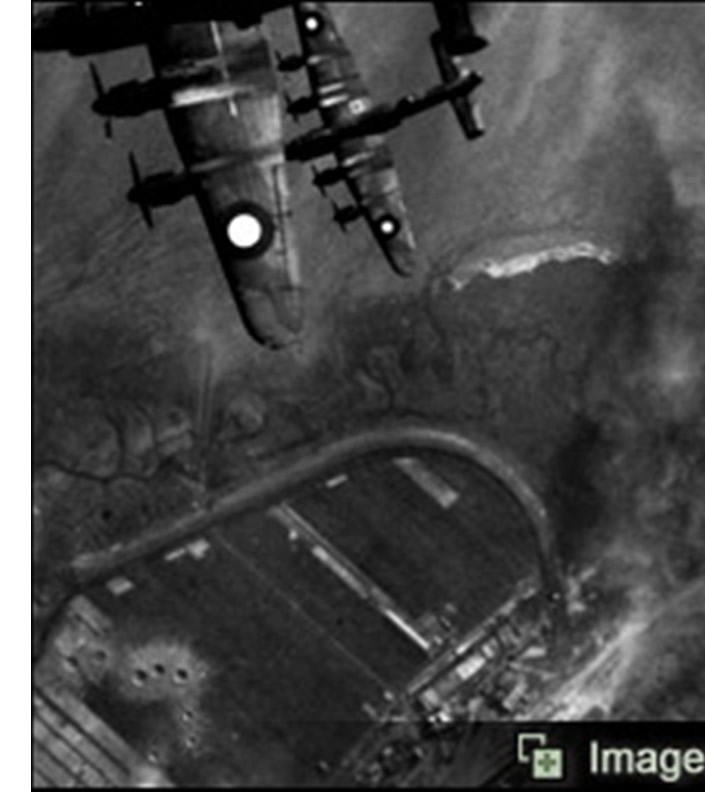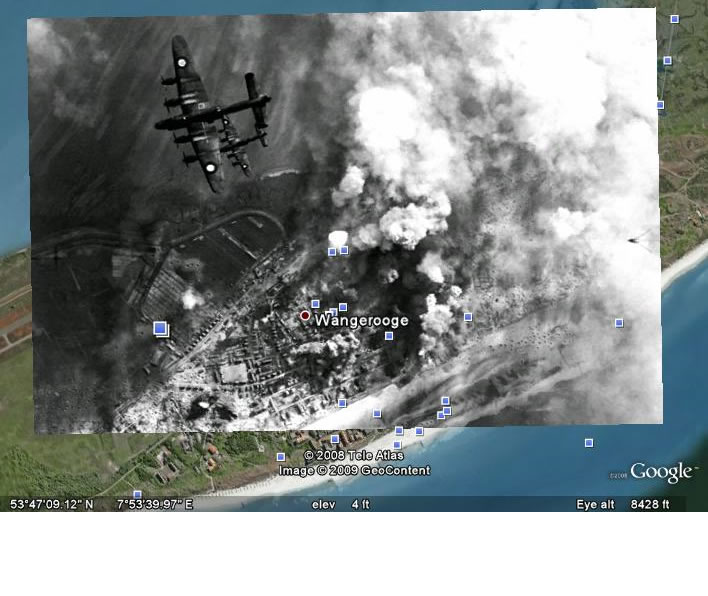433 Squadron (RCAF) 6 Group Skipton-on-Swale
Wangerooge - Planes Colliding April 25, 1945
National Defense Image Library PL 144281
Previous | Home | Next (Scroll Down to read RCAF Daily Ops reports on this operation)

6 Group’s last bombing raid was against the coastal batteries in Wangerooge, on the Friesian Islands, on April 25th, 1945. Five Canadian crews were lost following a chain collision.
Source Library and Archives Canada and http://www.junobeach.org/e/4/can-tac-air-bom-e.htm
Note: Explanation of losses on raid below.
Description: Wangerooge: 482 aircraft - 308 Halifaxes, 158 Lancasters, 16 Mosquitos - of Nos 4, 6 and 8 Groups. 5 Halifaxes and 2 Lancasters lost. The raid was intended to knock out the coastal batteries on this Frisian island which controlled the approaches to the ports of Bremen and Wilhelmshaven. No doubt the experience of Antwerp, when guns on the approaches had prevented the port being used for several weeks, prompted this raid. The weather was clear and bombing was accurate until smoke and dust obscured the target area. The areas around the batteries were pitted with craters but the concreted gun positions were 'hardly damaged'; they were all capable of firing within a few hours. Part of the bombing hit a camp for forced workers and the holiday resort and many buildings were destroyed, including several hotels and guest houses, the Catholic church and two children's holiday homes, although these do not appear to have been occupied at the time of the bombing. |
April 25, 1945 Wangerooge-Coastal Guns
"92 Halifaxes from 408, 415, 425, 426, and 432 squadrons were joined by 100 Lancasters
from 419, 424, 427, 428, 429, 431, 433, and 434 squadrons on an attack of the coastal guns
at Wangerooge."
"The weather was clear and the crews were over the target at between 10,000 to 12,000 feet,
releasing 2,100,000 lbs of high explosives. According to reports the target area was well cratered.
This operation proved to be the last over enemy territory after two and a half years of effort. The
6 Group crews would not be asked to carry bomb loads over enemy held territory. As well as this
being the last operation, the group suffered its final casualties, but not at the hands of the enemy.
Sadly the 4 crews that failed to return were all due to mid-air collisions." www.rcaf.com
F/Lt. A. Ely, RCAF![]() , and crew from 408 squadron, flying Halifax MK VII NP-796,
, and crew from 408 squadron, flying Halifax MK VII NP-796,
coded EQ-M, failed to return from this operation.
-
Sgt. J. Hughes, RAF
P/O J. Brambleby, RCAF
F/O J. Stanely, RCAF
F/O A. Boyd, RCAF
P/O A. Rutter, RCAF
P/O V. Hovey, RCAF
There were no survivors in a mid-air collision.
F/Lt. B. Emmet, RCAF![]() , and crew, flying Lancaster X KB-831 SE-E,
, and crew, flying Lancaster X KB-831 SE-E,
failed to return from this operation.
-
Sgt. J. Simms, RAF
F/Lt. R. Stingle, RCAF
F/O W. Hanna, RCAF
W/O2 C. Mark, RCAF
Sgt. D. Faulkner, RAF
F/Sgt. R. Mellon, RCAF
F/O D. Baker, RCAF![]() , and crew, flying Lancaster X KB-822, coded SE-W,
, and crew, flying Lancaster X KB-822, coded SE-W,
failed to return from this operation.
-
Sgt. F. Smith RAF
F/O J. Cruickshank, RCAF
F/O L. Amos, RCAF
W/O2 P. Henrichon, RCAF
F/Sgt. J. Roy, RCAF
F/Sgt. L. Hiatt, RCAF
There were no survivors in a mid-air collision."
Qoutes courtesy of Richard Korval and his excellent site at www.rcaf.com
